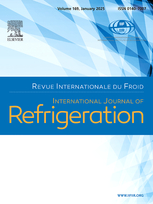
IIR document
Étude numérique et expérimentale du transfert de chaleur d’un refroidisseur de gaz sous pression de refoulement optimale.
Experimental and numerical study on heat transfer of gas cooler under the optimal discharge pressure.
Summary
This paper focuses on the heat transfer of gas cooler under optimal discharge pressure. Compared with experimental results, the scale of CO2 temperature dropping is found smaller in simulation. To make the model data more accurate, previous studies emphasized the modification of the heat transfer coefficient from the CO2 side, which is considerably higher than the water side. Through the analysis of LMTD and principle of cask effect, it is concluded that the heat transfer coefficient of water has a greater effect on the gas cooler model than that of CO2. Based on Buckingham PI analysis and its experimental results, a new dimensionless correlation on the water temperature rise was obtained. When calculating the heat transfer coefficient of water side with this correlation, the average error ratio exhibited a relative decline of about 10.26% (for temperature °C). The squared correlation coefficient of about 0.97815 also indicated a significant improvement on the accuracy of the model. The revised model can provide a reliable basis for the new gas cooler design.
Available documents
Format PDF
Pages: 229-239
Available
Public price
20 €
Member price*
Free
* Best rate depending on membership category (see the detailed benefits of individual and corporate memberships).
Details
- Original title: Experimental and numerical study on heat transfer of gas cooler under the optimal discharge pressure.
- Record ID : 30027397
- Languages: English
- Source: International Journal of Refrigeration - Revue Internationale du Froid - vol. 112
- Publication date: 2020/04
- DOI: http://dx.doi.org/10.1016/j.ijrefrig.2019.12.026
Links
See other articles in this issue (30)
See the source
Indexing
-
Themes:
Heat transfer;
CO2;
Insulants - Keywords: Heat pump; CO2; R744; Heat transfer coefficient; Water; Discharge; Modelling
-
Wyznaczanie wspólczynnika przejmowania ciepla p...
- Author(s) : MIKIELEWICZ D., JAKUBOWSKA B.
- Date : 2015/01
- Languages : Polish
- Source: Chlodnictwo - vol. 50 - n. 1-2
View record
-
Mathematical model of a heat exchanger working ...
- Author(s) : ZABET I., LEMORT V., TÂRLEA G. M.
- Date : 2012/06
- Languages : English
- Source: Scientific Journal of the Technical University of Civil Engineering Bucharest, Mathematical Modelling in civil Engineering - vol. 8 - n. 2
View record
-
A research on the dryout characteristics of CO2...
- Author(s) : JIANG L., LIU J., ZHANG L., et al.
- Date : 2017/11
- Languages : English
- Source: International Journal of Refrigeration - Revue Internationale du Froid - vol. 83
- Formats : PDF
View record
-
Effect of lubricating oil on flow boiling heat ...
- Author(s) : DANG C., HARAGUCHI N., YAMADA T., et al.
- Date : 2013/01
- Languages : English
- Source: International Journal of Refrigeration - Revue Internationale du Froid - vol. 36 - n. 1
- Formats : PDF
View record
-
Supercritical CO2 as heat transfer fluid: A rev...
- Author(s) : CABEZA L. F., GRACIA A. de, FERNÁNDEZ A. I., et al.
- Date : 2017/10
- Languages : English
- Source: Applied Thermal Engineering - vol. 125
View record
